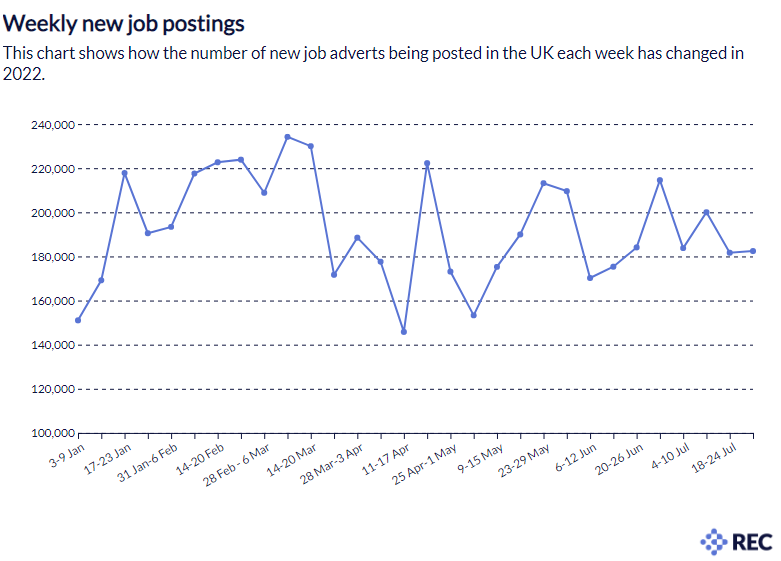- In the last week of July, there were 1.85 million job adverts in the UK, a new record high for 2022
- The number of new job postings has stayed relatively stable, with between 180,000 and 200,000 new adverts in each of the past four weeks
- Notable increases in adverts for occupations such as actors and entertainers, driving instructors, and dancers, as well as water and sewage plant operatives
- Three out of the UK’s top ten hiring hotspots were in London in the week of 25-31 July
- Meanwhile, five of the bottom ten local areas for growth in job adverts were in Scotland
In the week of 25-31 July, the number of active job adverts across the UK hit a new record high for 2022, according to the Recruitment & Employment Confederation (REC)’s latest Labour Market Tracker. At 1.85 million, active job postings have been slowly but steadily rising since mid-June.
The number of new job adverts being posted each week has remained relatively stable during late June and July, at between 180,000 and 200,000 per week. In the last week of July there were 182,000 new postings – 22% below this year’s highest figure of 234,000, recorded in the beginning of March.
The rising number of active postings overall likely reflects job adverts being left open for longer, with employers across the country struggling to attract candidates for their vacancies. Therefore, despite labour shortages, rising inflation and energy costs, there is no sign that the jobs market is starting to shrink.
Kate Shoesmith, Deputy CEO of the REC, said:
“This new data shows the continued strength of the jobs market, despite any wider economic uncertainty. The number of job adverts being posted each week is stable. It’s a great time to be looking for work as a jobseeker, as employers are having to think more about the pay, benefits, conditions and development opportunities they offer both new starters and current staff as they compete for talent.
“There is a danger that with costs soaring, employers will have to reprioritise – as there is still no viable support package for businesses to meet these rising costs. We know that employers’ confidence in the broader economy has started to drop. Government must play its role, both in supporting people and businesses through the current crisis, and also by working with industry to create a sustainable labour market. We need a long-term workforce strategy that encompasses skills, immigration and makes childcare and local transport part of the infrastructure of our labour market.”
There was a significant increase in adverts for actors and entertainers (+13.0%), driving instructors (+12.4%), and dancers (+11.1%) in the last week of July. Water and waste roles also saw a rise in postings, including water and sewerage plant operatives (+9.5%) which could be related to the prolonged dry weather and fears of droughts.
On the other hand, probabtion officers (-10.4%) saw the biggest weekly decline in active job adverts. The health and social care sector also recorded notable decreases – including for hospital porters (-8.3%), childminders (-6.6%), and paramedics (-5.3%).
London saw growth in job postings in the week of 25-31 July, with three of the top ten hiring hotspots in the capital. However, the local area with the highest increase in job adverts was Newry, Mourne and Down in Northern Ireland (+8.3%), followed by Haringey and Islington (+7.1%) and Chorley and West Lancashire (+7.0%).
At the other end of the scale, five out of the bottom ten local areas for growth in active job postings were in Scotland. Of those, Moray (-9.8%), Orkney Islands (-6.6%), and Highland (-5.1%) saw the biggest falls.
John Gray, Vice President, UK Operations at Lightcast, said:
“Whilst the economic headlines appear to be very gloomy at the moment, with the Bank of England forecasting inflation of more than 13% and a contraction in GDP until the end of 2023, this bleak picture does not appear to have dented employer hiring activity as yet. Not only have we just seen another 180,000 new job postings being placed in the last week of July, but the total number of active job postings is now at a record high of more than 1.8 million.
“This situation of a contracting economy, high inflation, yet employer hiring activity hitting record highs, is highly unusual. Whilst we are likely to see a slowdown in hiring activity, the big questions hovering over the labour market in the coming months are how significant this slowdown will be, and whether we will also start to see employers laying off staff. So far we are not seeing any signs of either, and the labour market remains surprisingly tight given the adverse economic circumstances we are hearing about.”







